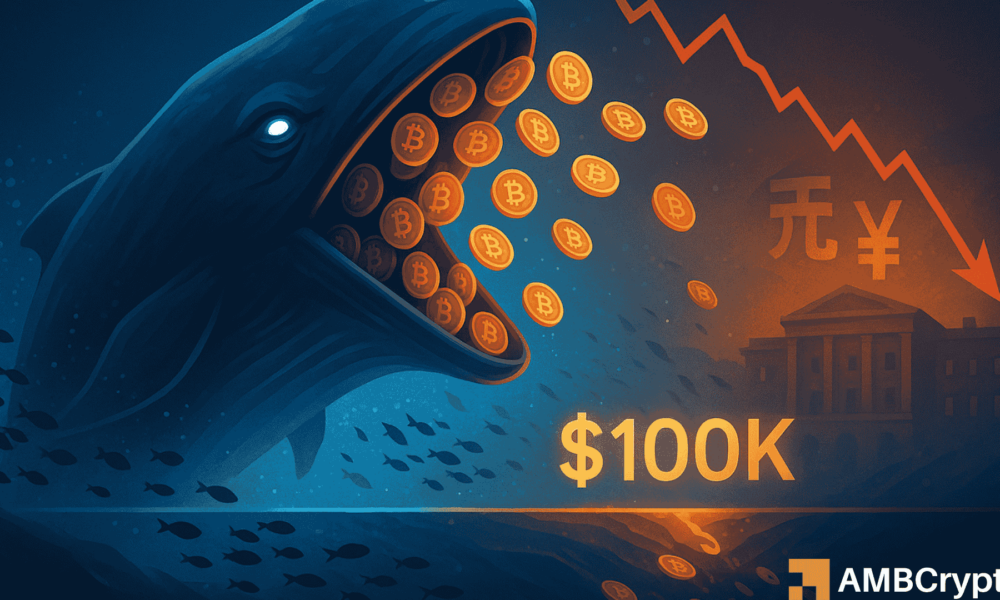The Current Landscape of Bitcoin: Whale Accumulation and Market Dynamics
The cryptocurrency market is experiencing a significant shift, marked by the unusual behavior of Bitcoin (BTC) investors—particularly whales, who have recently intensified their accumulation while long-term holders are offloading their assets. Recent data reveals that whales have added an impressive 45,000 BTC over the past week, positioning this period as the second-largest weekly accumulation of 2025. As these market dynamics unfold, it’s essential to interpret the underlying sentiments driving both bullish and bearish trends.
Whales vs. Long-term Holders
Recent statistics from CryptoQuant indicate that long-term holders have sold a staggering 815,000 BTC in just 30 days. This wave of distribution, the most significant since January 2024, highlights a key behavioral pattern within various holder categories. From seasoned investors with over seven years of holdings to those who entered the market more recently (6-18 months ago), the current landscape reflects a growing trend toward profit-taking. The spike in selling activity correlates with Bitcoin’s climb above the $100,000 mark, prompting many holders to liquidate assets accumulated during years of market recovery and consolidation following the 2022 downturn. This massive wealth transfer serves as a critical indicator of market sentiment and caution.
Accumulation by Whales: A Contrasting Narrative
In stark contrast to the sell-off among long-term holders, whale wallets—those holding over 1,000 BTC—have recently engaged in aggressive accumulation behaviors. Historically, whales tend to take advantage of market fear, and this trend is no different. With a notable increase in whale holdings from 1.52 million BTC to 1.76 million BTC, they have effectively absorbed the panic selling occurring among retail investors, whose total holdings have slightly decreased from 16.7 million BTC to 16.68 million BTC. This divergence exemplifies a recurring pattern in the crypto market: while retail investors capitulate near local highs, institutional players capitalize on market dips, essentially setting the stage for future bullish trends.
Market Sentiment: A Tug of War
The current price of Bitcoin hovers around $100,282, a key psychological barrier that is being tested as market momentum wanes. Analysis using the MACD (Moving Average Convergence Divergence) indicator reveals negative readings of -321.31, indicating ongoing bearish pressure that could impede upward movement. With the price having pulled back from an October high of $125,000, the technical indicators suggest that sellers maintain control despite the notable accumulation efforts from whales. This dynamic of conflict between bullish and bearish forces is critical to understanding short-term price fluctuations.
The Critical Support Level
At this juncture, the $100,000 level acts as a pivotal battleground for Bitcoin’s price action. A sustained break below this threshold could lead to a decline towards $97,500, a point of previous consolidation that may trigger further selling pressure. However, if whales continue to absorb sell-offs at current prices, their activity might carve out a foundation for the next bull run. Such a scenario would hinge on the juxtaposition of retail capitulation against institutional conviction, ultimately favoring long-term bulls willing to endure short-term fluctuations for potential future gains.
Behavioral Dynamics Define Market Trends
The ongoing narrative surrounding Bitcoin emphasizes the behavioral patterns that shape the cryptocurrency market. Historically, smart money—represented by whales—has engaged in practices that refine the trends through cycles of accumulation and distribution. By consistently buying during fear-based sell-offs and retail investors selling into market strength, a dichotomy arises that can foreshadow future market movements. Understanding these dynamics not only informs investment strategies but also solidifies the relationship between market sentiment and price action, ultimately guiding traders and investors in navigating the complexities of Bitcoin markets.
In summary, the contrasting behaviors of whales and long-term holders establish a clear narrative within the Bitcoin market. While significant distribution occurs among long-term investors, whales are taking advantage of this moment by accumulating coins at favorable prices. Assessing these trends, coupled with critical support levels and market sentiment, is vital for understanding Bitcoin’s evolving landscape. As we progress further into 2025, the focus will remain on how these dynamics influence future market actions and potential price movements in the cryptocurrency arena.


